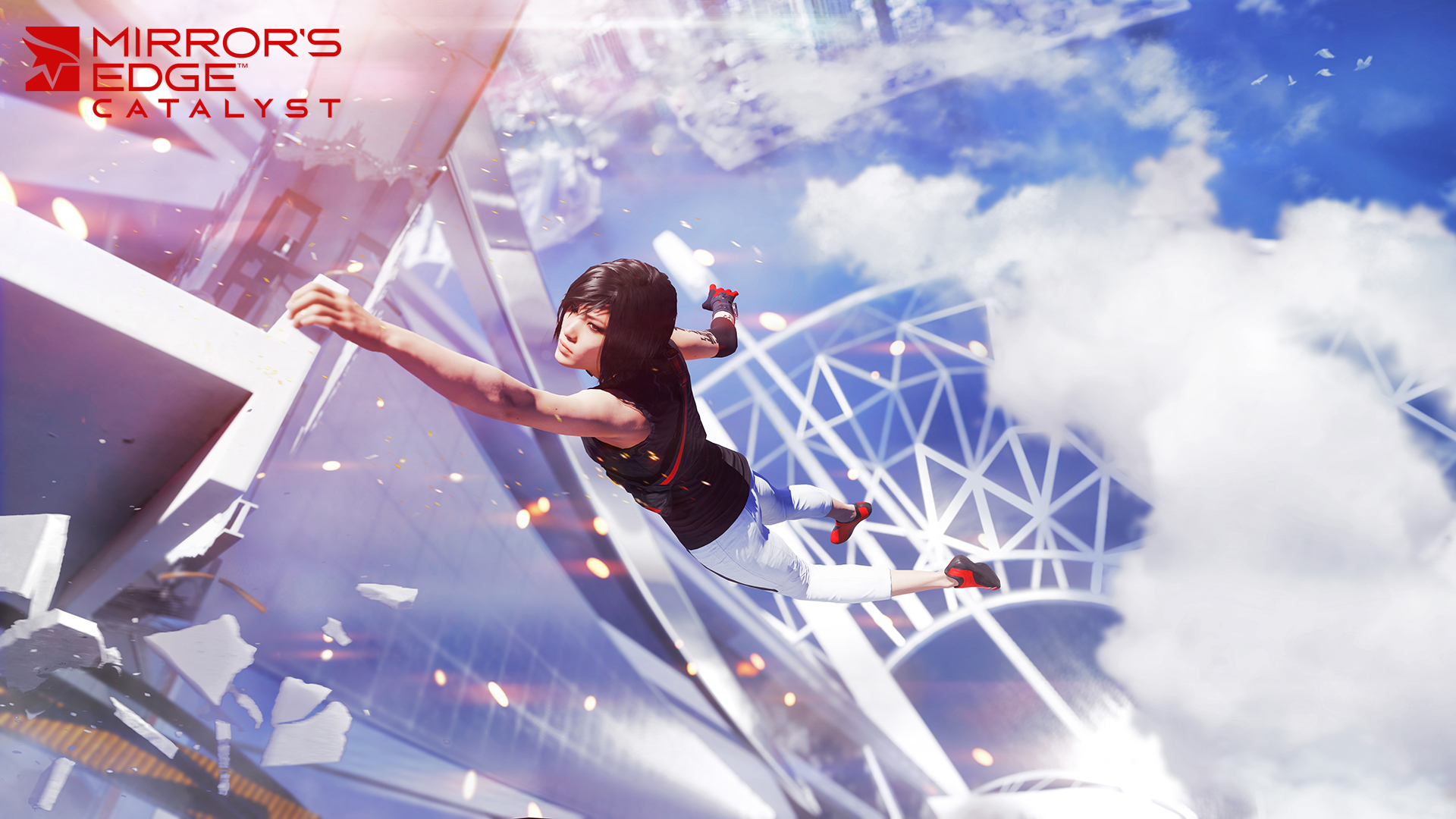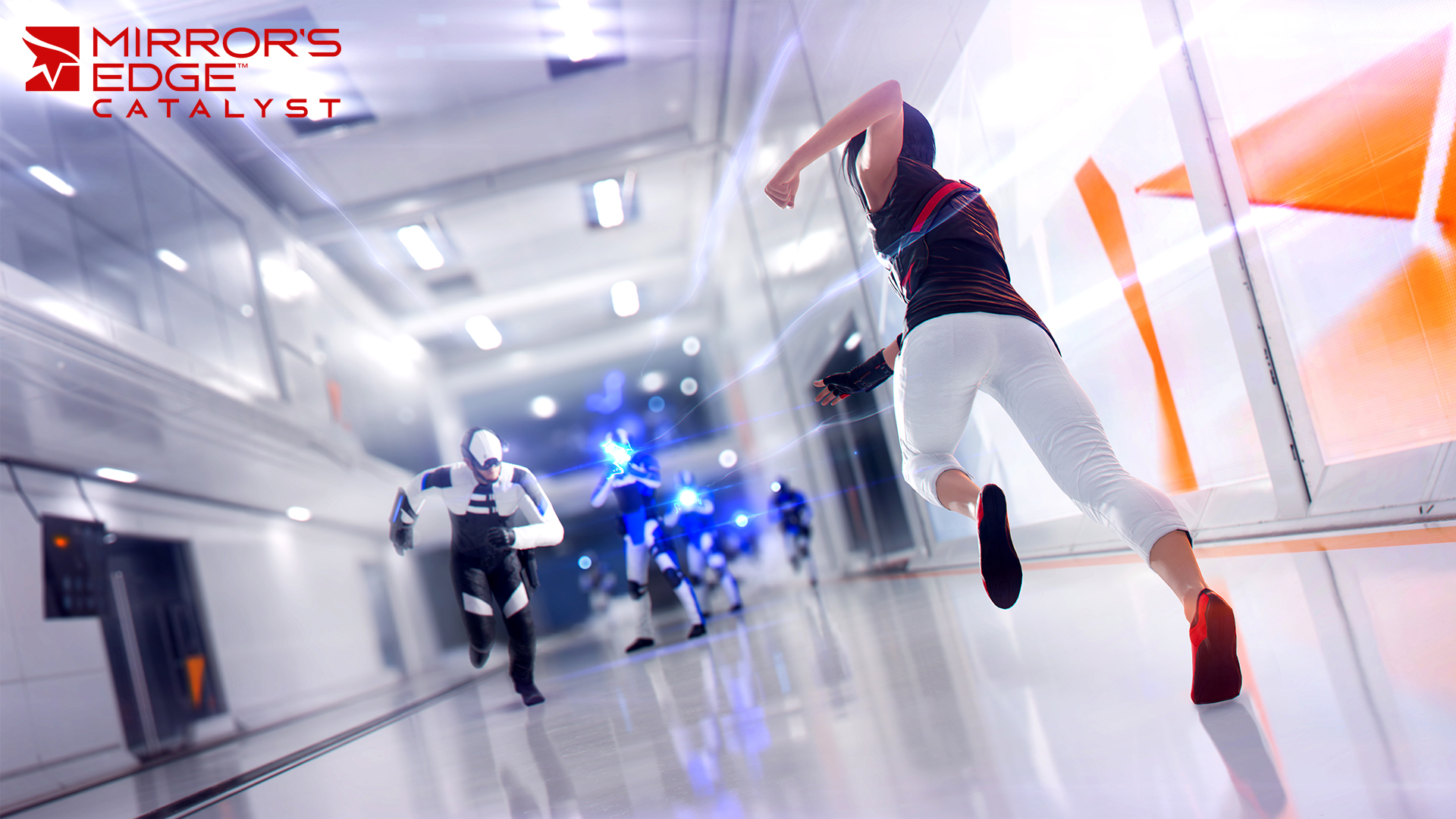
Towards the end of the original Mirror’s Edge, there’s an area that exemplifies most of what studio EA DICE’s 2008 first-person parkour game got right. You’re in an empty atrium and asked to find your way up along a succession of platforms obscured by a lattice of scaffolding. Dazzling sunlight makes the room’s lemon and white checkerboard walls glow. Ambient electronica pings and blips soothingly. Looking at a five-story high maze of concrete, rebar and piping, you wonder “How in the world am I going to scale this?”
That’s for you to puzzle out, and the moment for me the game finally came together. You had to probe for connection points, then tilt the view just so to attempt gasping wall-runs, scrambling climbs and heart-stopping leaps. Watching vets play this sequence now, amounts to a few minutes of surefooted clambering. But my first try took over an hour sorting runnable routes from red herrings. It’s one of my favorite sequences in a video game, a kind of “Zen of investigatory acrobatics” set against an exquisite Mondrian canvas.
Similar gameplay is the sublime center of 2016’s Mirror’s Edge: Catalyst, EA’s overdue series rethink for PC, PlayStation 4 and Xbox One released June 7.
Unfortunately, to get to it you have to ford through a lot of filler. Instead of advancing protagonist Faith’s rooftop struggle with a cabal of autocrats, Catalyst reinvents then situates it in an open-world rendition of the original’s stunning, bleached-white metropolis. That utopia now has a name, Glass, a gleaming city in which despotic plutocrats for some reason tolerate factions of superhumanly spry “Runners.” These unabashed thrill-junkies perform a kind of Olympic snail-mail service by bounding between skyscrapers to deliver black market items or messages covertly. As the game opens, Faith—a legendary Runner herself—is fresh out of juvie, in debt to a leg-breaker and on the verge of unraveling a sweeping conspiracy.
So yes, there’s a plot here you can chase that reduces the game’s open-world to 15 linear sprints from this point to that one. Corporate underlings pop up along the way—more irritant than threat since you can generally run right past them. And in a few instances there’s a ruthless timetable to beat. But mostly you’re tailing “runner’s vision,” the game’s candy-apple-red GPS that guides you through Glass’s urban jungle to tag an endpoint, punch a button and watch a cutscene. The villains are boring, hand-to-hand combat feels clumsy and pointless (at least the gunplay’s gone), the story’s typical pablum that telegraphs its twists too soon, and these things ultimately stand between you and Catalyst‘s far better free-range gameplay.
Veer off toward the broader city’s jutting structures and labyrinthine byways, and Catalyst becomes something else entirely—a glittering playground of kinetic possibility. Here you can explore and maneuver as you like, running routes to challenge a leaderboard of players’ best times, or devising grueling runs of your own that show up on other players’ maps. This is where slowing down becomes paramount, however counterintuitive. You’ll finish a route with a one or two star (of three) rating and notice an outlier score that’s somehow 10 or 20 seconds faster than yours, then realize there’s a completely different way to come at the course.
Catalyst hides those alternate routes in plain sight, then slyly misdirects you. Runner’s vision becomes a literal red herring, guiding you along the surest but most median routes. Follow it deftly and you won’t fail, but you’ll also be no threat to a route’s top scorers. Beating or coming close to those figures depends on how much you’re into the idea of sleuthing for alt-routes, then honing your progress through them.

Whether this way of approaching Catalyst resonates also depends on your patience for finessing small but critical things: A turn better taken as a wall-jump. A low-lying barrier leveraged to catapult you higher. Leaping to a ledge while running from several feet away. Timing the pull of a gamepad trigger after a precipitous fall to regain lost momentum. Every microsecond counts. Thus you’ll practice, then practice some more, the reward less a brag-spot on the socreboard than in achieving meaningful command of a seamless chain of motion that’s at once balletic and visually powerful.
Part of it’s simply how you respond to the aesthetics of the world itself. Most utopias steeped in geometric perfection wind up feeling merely sterile (as if anyone really wants to live in a world of anti-idiosyncratic, monochrome blah). Glass may be the first idealist dystopia that’s genuinely appealing despite its metaphorical nod to whitewashing. There’s something gloriously weird and viscerally stirring about an entire city painted gaze-searing white, bathed in blue-sky sunlight, then intercut by Skittles-bright reds, greens, yellows and oranges. Think IKEA by way of Jony Ive.

I called the original Mirror’s Edge “a wild streak of brave new gaming.” And it was. Eight years later, it still feels like nothing you’d expect a studio known mostly for the mainstream Battlefield games to do. Nothing else looks or plays like Catalyst. If you can stomach plowing through the story–and you have to, to fully unlock the map–the game’s open world comes brimming with things to do: delivery missions, time trials, stalking collectibles, marking Easter eggs for friends, hacking towering grid nodes (enemy-free climbing puzzles like the atrium level described above) or figuring out how to scale obscurely situated billboards.
I just wish there were some way to skip right to that stuff from the start, because Catalyst works best when you’re ignoring its fiction, moving through its three-dimensional celebration of neoplasticism, crafting an experience that unfolds in an exhilarating interplay of form and motion and light.
4 out of 5
Reviewed on PlayStation 4
More Must-Reads from TIME
- Donald Trump Is TIME's 2024 Person of the Year
- TIME’s Top 10 Photos of 2024
- Why Gen Z Is Drinking Less
- The Best Movies About Cooking
- Why Is Anxiety Worse at Night?
- A Head-to-Toe Guide to Treating Dry Skin
- Why Street Cats Are Taking Over Urban Neighborhoods
- Column: Jimmy Carter’s Global Legacy Was Moral Clarity
Write to Matt Peckham at matt.peckham@time.com